
















We left Lake Ohau and drove through the Lindis Pass (above). Just looking at the mountain ranges you can imagine the sheer force needed to make mountains. New Zealand sits on two tectonic plates, one on the west coast and one on the east coast. Because of this, its mountains are still growing, at a rate of 1-2 cm a year. Pretty crazy.
We made our morning pitstop in Cromwell, known for its fruit growing. We stopped at a famous fruit stand, where we saw how the leaves are changing for fall (above). In the fruit store, there were various kiwi-related products, like kiwi chocolate (above, yum!) and kiwi fruit. This is because the New Zealand national bird is the kiwi and New Zealanders themselves are called “kiwis.” In the back of the fruit stand was a rose garden, again pointing to NZ’s British heritage (above).
Then we drove near Queenstown and saw the Remarkables mountain range (above). They are remarkable because their peaks line up exactly north to south, and they are one of two mountain ranges in the world that are this way. Also, any Lord of the Rings geeks may recognize them, they make up the Walls of Mordor and are seen in other parts of the movie too.
We drove through Fiordland National Park, a World Heritage Area, to our final destination: Milford Sound. It turns out that Milford Sound is actually a fiord, as fiords are glacially formed and sounds are formed by rivers. Basically the entire west coast of the South Island is separated from the east by the Southern Alps mountain range, and the mountains go into the ocean through the fiords. There are tons of them (see map).
When we got to Milford Sound, we boarded the trusty vessel that would be our home for the night, The Wanderer (above). We threw our stuff into our bunks in the bottom of the boat, and checked out the view from our porthole (above). We began cruising around, and of course it was raining, so my pictures are very misty (above).
In the afternoon we had a chance to kayak on the sound. While the weather was terrible and the water was freezing, it was a chance we couldn’t pass up. They lowered the kayaks off of the back of the boat (above) with a rope, and we got in one by one. I have no pictures from this, I didn’t want to risk it with the rain. Kayaking was really awesome. We all thought that Milford Sound in the rain looked like something from Jurassic Park, with the really green forests poking through the mist. Mary and Brittany went swimming for about a minute (I didn’t because I got separated from them). They thought it was pretty much the coldest water they’d ever been in.
We warmed up with a fabulous dinner. Before we went to bed we helped our new South Korean friends translate our trip’s itinerary. One girl was an “American Studies” major, so her English was quite good, but the itinerary used some flowery language that we helped her with. It never occurred to me before that someone could major in American Studies. Crazy.
































